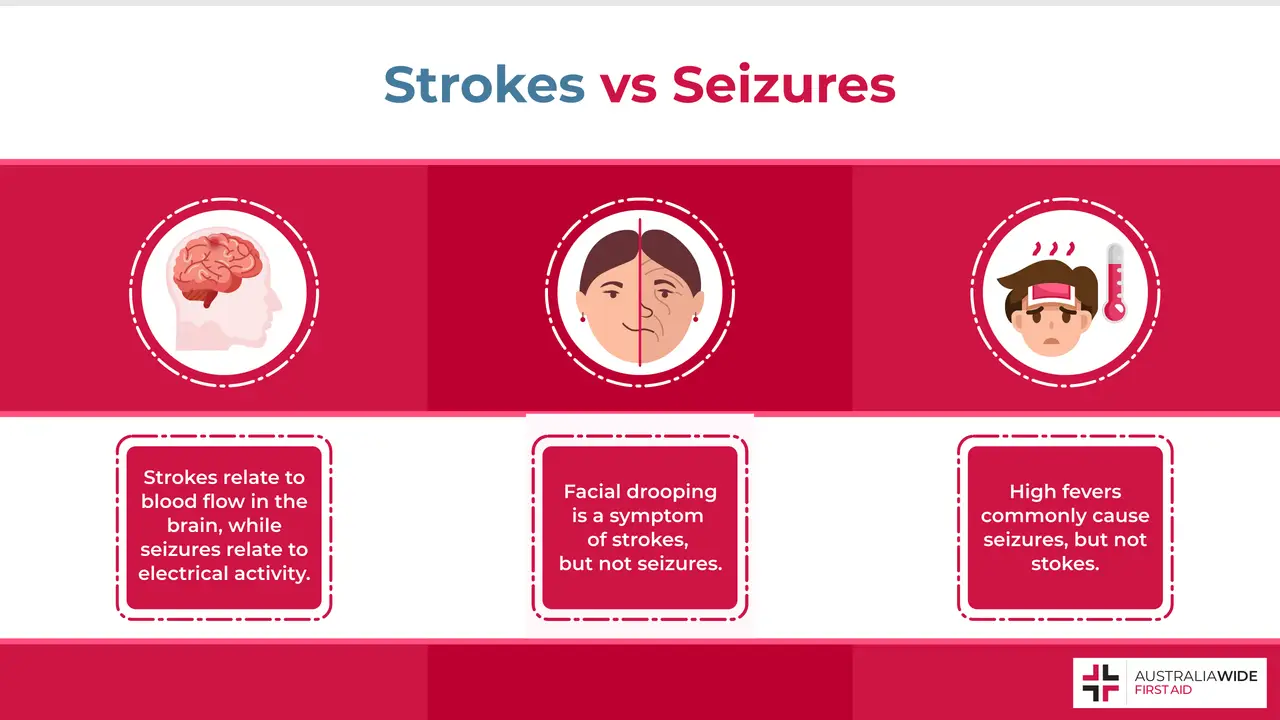3 Differences between Strokes and Seizures


Strokes and seizures can be confused with each other, as they are both serious medical emergencies affecting the brain.
However, while strokes are generally caused by a disruption to the brain’s blood supply, seizures are generally caused by a malfunction in the brain’s electrical activity.
They also have distinct symptoms, treatments, and risk factors. Continue reading for a more thorough understanding of how to spot a seizure from a stroke, and how to provide first aid accordingly.
A stroke occurs when the blood supply to a part of the brain is suddenly disrupted.
This can cause brain cells to die, as they rely on blood to receive life-sustaining oxygen and nutrients.
If a stroke victim does not receive prompt medical treatment, whole swathes of their brain can die, and they can sustain permanent brain damage and requisite physical, emotional, and intellectual complications.
Strokes can occur in three primary forms, each of which have their own individual causes:
Our brain controls all our bodily functions, including our thoughts, emotions, and motor skills.
Our body does this by using neurons to receive information from, and relay information to, different parts of the body.
Neurons, in turn, communicate with one another using a form of electricity – seizures occur when a sudden and excessive burst of electrical activity in the brain disrupts the regular pattern of these electrical impulses.
There are many different types of seizures, and they are classified according to whether the casualty remained aware during the seizure, how the casualty moved during the seizure, and in which part of the brain the seizure originated from.
The three major groups of seizures are:
The most common cause of seizures is epilepsy, a neurological disorder marked by recurrent episodes of abnormal electrical activity in the brain.
However, not everyone who has a seizure has epilepsy. Seizures can be caused by anything that inhibits neurons from sending and receiving electrical impulses, including:
The Stroke Foundation recommends using the acronym F.A.S.T to remember the main symptoms of stroke.
As cited by the American Stroke Association, the letters of F.A.S.T represent:
Other possible signs of stroke include:
The symptoms of TIAs are indistinguishable from those of ischaemic or haemorrhagic strokes, though they tend to resolve themselves completely within 24 hours.
The Stroke Foundation is a national charity that coordinates initiatives and partners with the community to raise awareness about the risk factors and signs of stroke, with an end to improve the outcomes of those who have strokes. One such initiative is National Stroke Week. To learn more about the focus of this year's National Stroke Week, head to our Resource Library.
The nature and severity of symptoms vary according to the type of seizure a person experiences.
Many people describe having an ‘aura’ prior to their seizure – a foreboding sense that something is about to happen, and which can be characterised by odd smells, feelings of deja-vu, or pins and needles.
In general, seizures are signalled by changes in a person’s movements, behaviours, and awareness, and can include:
For all seizures, regardless of cause, you should consult the following first aid treatment:
It is important to remember, there is no danger that the casualty will swallow their tongue while seizing. As such, you should not put anything in their mouth, nor attempt to restrain them. In fact, you should only move the casualty if they are in danger.
Strokes and seizures are both caused by disruptions to the brain’s function.
Strokes generally occur when there is a blockage or rupture in one of the vessels supplying blood to the brain, while seizures generally occur when there is a surge of electrical activity in the brain’s nerve cells.
While experiencing strokes and seizures, casualties generally lose control of their thoughts, behaviours, and motor skills.
As such, it is important to know the differences between strokes and seizures, so you can provide appropriate first aid and reduce the casualty’s risk of long-term health complications.
To learn more about the risk factors and signs of stroke, check out the National Stroke Foundation and their awareness campaigns, including National Stroke Week. And to learn even more about how to assist those in a health crisis, book a First Aid course with us today!

May 1, 2025
Pterygium, also known as surfer's eye, is an ocular surface disease characterised by a growth of limbal and conjunctival tissue over the cornea. Fortunately, you can practice many eye health habits to help prevent the development of pterygium and other risks.

April 3, 2025
Tuberculosis is a severe bacterial infection that mainly affects the lungs and other parts of the body, including the nervous system. This contagious disease can quickly spread in crowded areas when an infected person coughs, talks, or sneezes.

February 13, 2025
Melioidosis is a bacterial infection caused by Burkholderia pseudomallei, a microorganism found in soil and water. This infection is often underdiagnosed due to symptoms mimicking many other illnesses. As such, awareness is critical for those living or working in affected regions.